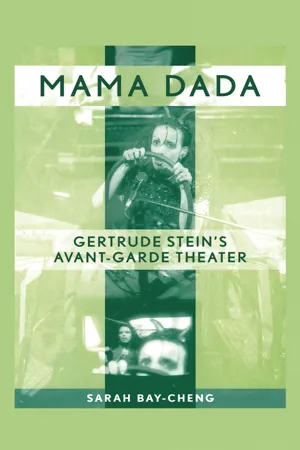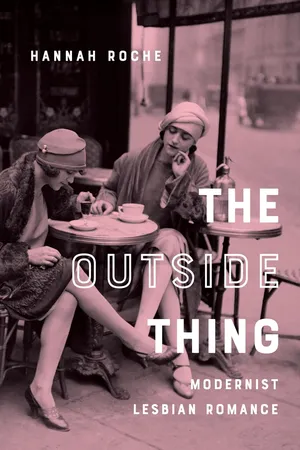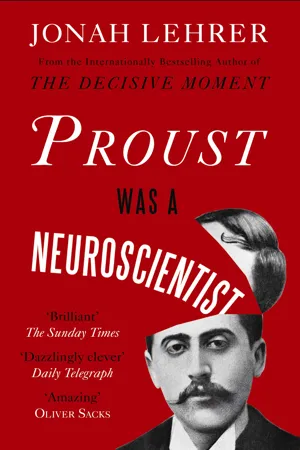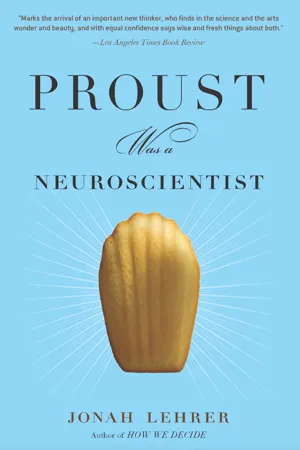History
Gertrude Stein
Gertrude Stein was an influential American writer and art collector known for her avant-garde literary works and her role in the Parisian art scene during the early 20th century. She is particularly remembered for her experimental writing style, which often focused on themes of identity, language, and perception. Stein's literary salon in Paris also played a significant role in shaping modernist literature and art.
Written by Perlego with AI-assistance
Related key terms
Related key terms
1 of 4
Related key terms
1 of 3
6 Key excerpts on "Gertrude Stein"
- eBook - ePub
Mama Dada
Gertrude Stein's Avant-Garde Theatre
- Sarah Bay-Cheng(Author)
- 2004(Publication Date)
- Routledge(Publisher)
Everything in the modern theater has been touched by Stein's recognition of the English language. She freed the theater in every dimension. She simply plowed everything under and allowed us a wide field to experiment with new forms. And the seeds she planted have continued to grow. (Watson 304)Yet, despite her importance and influence, Stein has been marginalized in studies of the American theater, even those concentrated on the avant-garde. Michael Vanden Heuvel comments in Performing Drama/Dramatizing Performance (1993) that "Stein's influence on [Robert] Wilson and other elements of the contemporary avant-garde has been largely neglected" (245). It was not until quite recently that Stein has been considered a significant influence on American avant-garde theater, and despite essays such as Kate Davy's "Richard Foreman's Ontological-Hysteric Theatre: The Influence of Gertrude Stein" and Randi Koppen's "Formalism and the Return to the Body: Stein and Fornes's Aesthetic of Significant Form," Stein has been predominantly represented as a personality to be adapted and replayed in American theater, rather than as a significant dramatic predecessor. (This prominence of her personality over her writing bothered her throughout her life as well.) Even recent considerations place a lopsided emphasis on Stein as the personality. In the title to her article in American Theatre , for example, Celia Wren asks the question "Why Has Gertrude Stein Become a Recurrent Character on America's Stages?" (30). Despite numerous recent productions of Stein's plays (over 20 professional productions since 1992), Wren focuses primarily on productions in which the character of Gertrude Stein appears, but largely ignores the presence of Stein's own work in American theater.Undoubtedly, part of this critical neglect can be attributed to the marginal position of drama within the Stein canon. However, the complexity of Stein's influence also prohibits a clear path of reaction in American theater. For example, Stein is a key influence for John Cage, who in turn collaborated with Merce Cunningham, the Living Theater, the Judson Church Dance Theater, and the educational experiment known as Black Mountain College. But while Stein was certainly an influence on these artists, Antonin Artaud's newly translated The Theater and Its Double - eBook - ePub
American Literature in Context
1900-1930
- Ann Massa(Author)
- 2016(Publication Date)
- Routledge(Publisher)
2 and her practice proved her point: ‘Living, loving, eating, pleasing, smoking, thinking, scolding, drinking’. The sequence of ‘ing’ sounds, modulated by their preceding syllables, conveys infinite clarity, infinite variety. The sounds suggest life and have life too.Gertrude Stein represents the American dimension of what was happening elsewhere in the arts and sciences in the early twentieth century. She was part of the intellectual revolt against the art of previous eras, and she is properly associated with that time when Einstein, Bergson, Russell and Freud were making revolutionary advances in physics, metaphysics, philosophy and psychology, and when in music and in painting the Cubists, the Fauves and Schoenberg were making new ‘harmonies’, connecting sounds and shapes and colours in new and what seemed at first to be strange and dislocated ways, ways as strange as Gertrude Stein’s prose. Indeed her writing resembled the cubist fragmentation of conventional perspective and its use of interlocking planes, and like the Fauves, she boldly dismantled traditional forms. She believed that if we abandon the ‘structures’ – be they visual or syntactical – which we have imposed on time and space, on our universe and on our language, we will achieve unimpeded access to our consciousness. Natural flow would replace artificial order. Literature would become like life: it would be always in motion. And as an American she felt she had a head start, as she explained in 1934.I am always trying to tell this thing that a space of time is a natural thing for an American to always have inside them as something in which they are continuously moving. Think of anything, of cowboys, of movies, of detective stories, of anybody who goes anywhere or stays at home and is an American and you will realize that it is something strictly American to conceive a space that is filled with moving, a space of time that is filled always filled with moving and my first real effort to express this thing which is an American thing began in writing The Making of Americans.3 - Rick Honings, Gaston Franssen, Rick Honings(Authors)
- 2016(Publication Date)
- Palgrave Macmillan(Publisher)
Chicago Daily News (September 20, 1933, Beinecke YCAL MSS76) (Reproduced with permission of Beinecke)This double role of literary genius and public celebrity was increasingly the part Stein was forced to play after the publication of The Autobiography of Alice B. Toklas . Just as she had finally given in to write her memoirs, she relented at last to public demand and to the desire of her agent to tour the United States. As Stein recalls in Everybody ’s Autobiography (1937), she initially declined for a very specific reason: ‘And Mr. Bradley said I was making a mistake and I said no, Jo Davidson always said one should sell one’s personality and I always said only insofar as that personality expressed itself in work. It always did bother me that the American public were more interested in me than in my work.’28Here, Stein herself acknowledges the two sides of her personality, one represented by her work as writer, and one represented by her celebrity position as notable personality. She remembers being aware of the dangers of appearing in the media as celebrity author, a public image distinct from her textual body, even before the publication of The Autobiography had so profoundly placed her celebrated personality next to her personal expression in text, effectively separating and duplicating the public image of herself. However, the insight that this effect has everything to do with the nature of twentieth-century celebrity appears lost on Stein, as she ultimately offers her fame as the reason for her agreement to the lecture tour: ‘I used to say that I would not go to America until I was a real lion a real celebrity at that time of course I did not really think I was going to be one. But now we were coming and I was going to be one.’29Once Stein’s Autobiography- eBook - ePub
The Outside Thing
Modernist Lesbian Romance
- Hannah Roche(Author)
- 2019(Publication Date)
- Columbia University Press(Publisher)
I Gertrude SteinO n May 12, 2011, the Contemporary Jewish Museum in San Francisco unveiled a new exhibition that promised to share “an in-depth portrait of Gertrude Stein that knits together her many identities.”1 Seeing Gertrude Stein: Five Stories , as the title of the exhibition and accompanying book indicates, was presented in clearly demarcated sections, apparently leaving the visitor or reader to “knit together” the various facets of Stein’s identity. In The Making of Americans (1925), Stein articulates her inability to reconcile the various “pieces” of composite and repetitive identity:Sometimes I know and hear and feel and see all the repeating in some one, all the repeating that is the whole of some one but it always comes as pieces to me, it is never there to make a whole one to me. Some people have it in them to be in pieces in repeating the whole of them, such of them almost come never to be a whole one to me, some come almost all their living in repeating to be a succession not a whole one inside me.2Gertrude Stein has long invited interpretation as a series of paradoxes. Presenting herself as “completely and entirely american” despite a thirty-year absence from America, the provocative and often perplexing Stein has continued to attract scrutiny as a conservative lesbian, a radical stylist with reactionary politics, and “a Jew who became more and more hostile to Jews.”3 Stein’s linguistic complexity is obviously less disturbing than her friendship with Nazi collaborator Bernard Faÿ (as examined in Barbara Will’s second monograph on Stein, Unlikely Collaboration [2011]), but Sarah Posman has rightly described Stein’s language as “the American English of the daughter of German Jewish immigrants who had lived in three different countries before she turned five.”4 Stein’s intimate adult life as “Mr. Cuddlewuddle” in the rented French homes shared with Jewish partner Alice B. Toklas is somehow incompatible with the figure of “genius” presiding over her own very public salon.5 The title of Richard Bridgman’s “preliminary inventory of Gertrude Stein’s literary estate,” the most comprehensive work on Stein before the 2003 publication of Ulla E. Dydo’s The Language That Rises , supports the idea that Stein is best digested “in pieces.”6 - eBook - ePub
- Jonah Lehrer(Author)
- 2011(Publication Date)
- Canongate Books(Publisher)
* As one professor remarked, “Either I am crazy or Miss Stein is.”In 1903, just a semester away from graduation, Stein moved to Paris. She settled in with her brother Leo, who had an apartment at 27 rue de Fleurus. Leo had just purchased his first Cézanne painting — “Anyone can buy paintings in Paris,” he told Gertrude — and was beginning to enmesh himself in the local art scene. Gertrude made herself right at home. As she wrote in Everybody’s Autobiography, “I joined him and sat down in there and pretty soon I was writing.”Her early work was influenced by the artists who lingered around the apartment. Three Lives was inspired by a Cézanne portrait. Her next book, The Making of Americans, emerged from her relationship with Matisse. But Stein was closest to Pablo Picasso. As she wrote in her essay Picasso (1938), “I was alone at this time in understanding him because I was expressing the same thing in literature.”Their relationship began in the spring of 1905, just as Picasso was becoming bored with his blue period. Gertrude Stein asked him to paint her portrait. The painter couldn’t say no; not only had Stein’s Saturday-night salons become a magnet for the Parisian avantgarde (Matisse, Braque, and Gris were normally there), but Gertrude and her brother Leo were some of his earliest benefactors. Their walls were lined with his experiments.Picasso struggled with Stein’s portrait as he had never struggled with another painting. Day after day, Stein returned to Picasso’s apartment high in the hills of Montmartre. They talked while Picasso carefully reworked the paint on the canvas. They discussed art and philosophy, William James’s psychology, Einstein’s physics, and the gossip of the avant-garde. In Stein’s autobiography — mischievously titled The Autobiography of Alice B. Toklas - eBook - ePub
- Jonah Lehrer(Author)
- 2008(Publication Date)
- Mariner Books(Publisher)
* As one professor remarked, "Either I am crazy or Miss Stein is."In 1903, just a semester away from graduation, Stein moved to Paris. She settled in with her brother Leo, who had an apartment at 27 rue de Fleurus. Leo had just purchased his first Cezanne painting—"Anyone can buy paintings in Paris," he told Gertrude—and was beginning to enmesh himself in the local art scene. Gertrude made herself right at home. As she wrote in Everybody's Autobiography, "I joined him and sat down in there and pretty soon I was writing."Her early work was influenced by the artists who lingered around the apartment. Three Lives was inspired by a Cézanne portrait. Her next book, The Making of Americans, emerged from her relationship with Matisse. But Stein was closest to Pablo Picasso. As she wrote in her essay Picasso (1938), "I was alone at this time in understanding him because I was expressing the same thing in literature."Their relationship began in the spring of 1905, just as Picasso was becoming bored with his blue period. Gertrude Stein asked him to paint her portrait. The painter couldn't say no; not only had Stein's Saturday-night salons become a magnet for the Parisian avant-garde (Matisse, Braque, and Gris were normally there), but Gertrude and her brother Leo were some of his earliest benefactors. Their walls were lined with his experiments.Picasso struggled with Stein's portrait as he had never struggled with another painting. Day after day, Stein returned to Picasso's apartment high in the hills of Montmartre. They talked while Picasso carefully reworked the paint on the canvas. They discussed art and philosophy, William James's psychology, Einstein's physics, and the gossip of the avant-garde. In Stein's autobiography—mischievously titled The Autobiography of Alice B. Toklas
Index pages curate the most relevant extracts from our library of academic textbooks. They’ve been created using an in-house natural language model (NLM), each adding context and meaning to key research topics.
Explore more topic indexes
Explore more topic indexes
1 of 6
Explore more topic indexes
1 of 4





